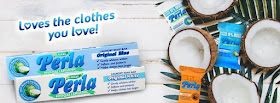The first coconut-oil based product from PMC were edible
products beginning with Purico vegetable shortening in 1919. When P&G of
Cincinnati, Ohio acquired PMC in 1935, it continued this venture, putting up its
own plant, but the operations were halted during the war when Japanese forces
occupied the plant in 1942.
But when thing settled, P&G PMC resumed its
operations, rebuilt the plant, and
forayed into coconut oil-base soap production. That was how PERLA came to be in
1949, one of the very first white detergent bars made from pure coconut oil and
natural ingredients.
As believers of advertising, P&G PMC began
advertising PERLA in 1951. The first
print ads basically promised many conveniences—“lots more suds with fewer rubs”,
“gets whites white—no yellowing”, “no color fading”. “safe as clean water”.
Later, PERLA’s
benefit became more focused, with the addition of a “sunshine ingredient”—Supersol—for
the whitest, brightest of clothes.
It would take over 2 decades before PERLA found its niche
when repositioned as the soap that gently cleans clothes—especially those made
of delicate fabrics like undergarments, lacey apparel, lingerie and heirloom
clothes. This insight actually came from PERLA
users themselves who stood by the gently cleaning ability of the soap—as it was
made from pure, natural ingredients.
In fact, a secondary usage was also unearthed.
Apparently, women were also using PERLA
to wash their faces as part of their skincare regimen. Thus, the added benefit
of “keeping hands in good condition after every washing” was incorporated in
its messaging thru the 1980s. the advertising was handled by Ace-Compton
Advertising, and later by Publicis-Jimenez Basic in the mid 1990s.
PERLA was sold
to SCPG Asia-Pacific, a manufacture of soaps, detergents and washing Powders after 1994. Currently, Mt. Makiling International
Oil, Inc. is toll manufacturer of PERLA, housed by SCPG Asia-Pacific Inc. After 70 years, the iconic white bar—PERLA—is still around, with new
variants (Blue) and revitalized formulation (with papaya extract) to keep up
with the demands of the times.
SOURCES:
Perla FB Page, https://www.facebook.com/perlaphilippines/
Then and Now, Progress Report Magazine, 1958
































